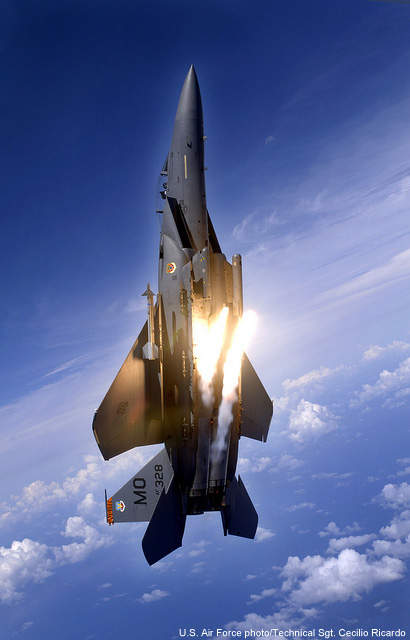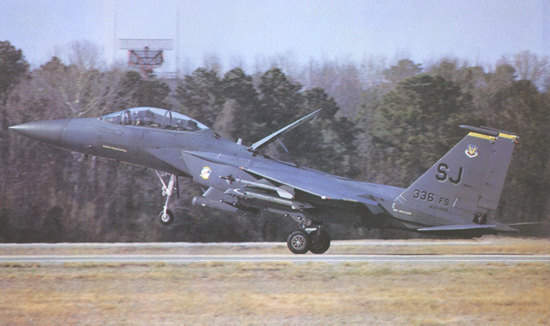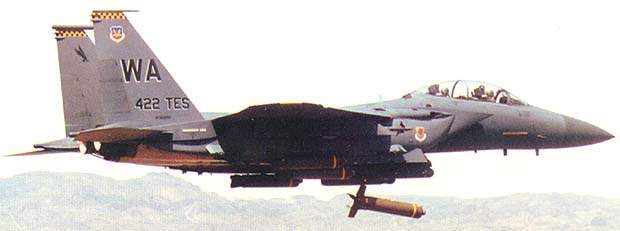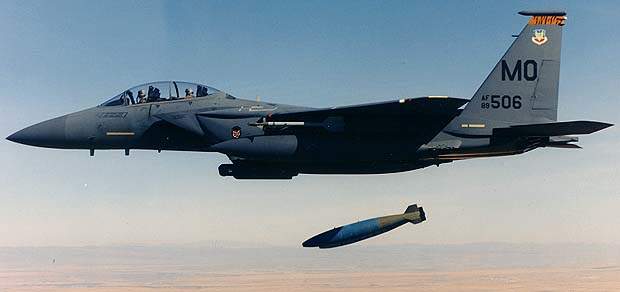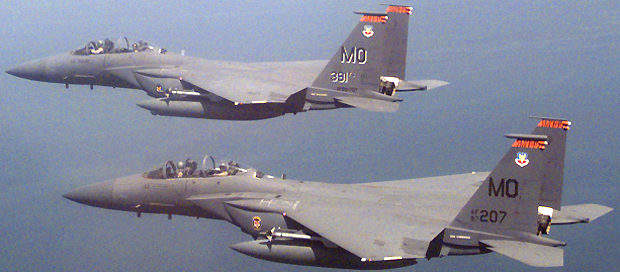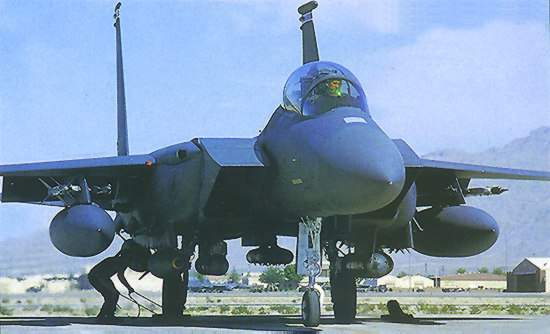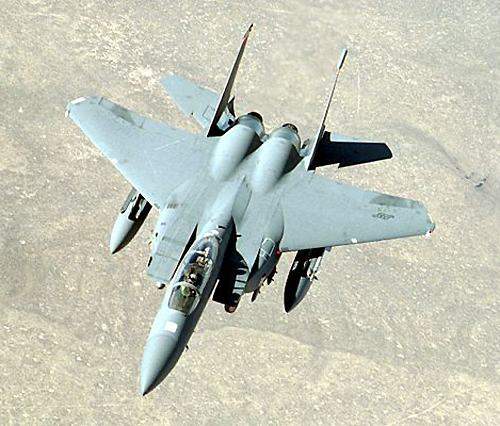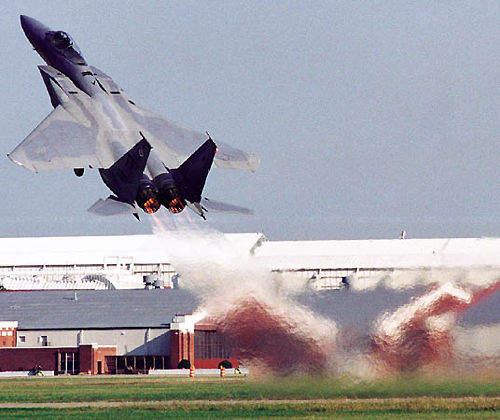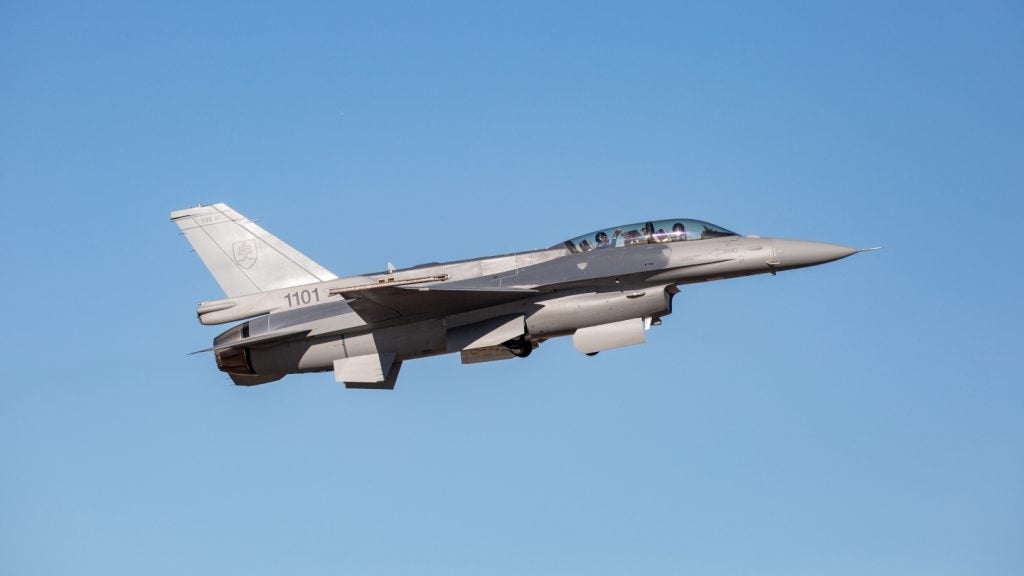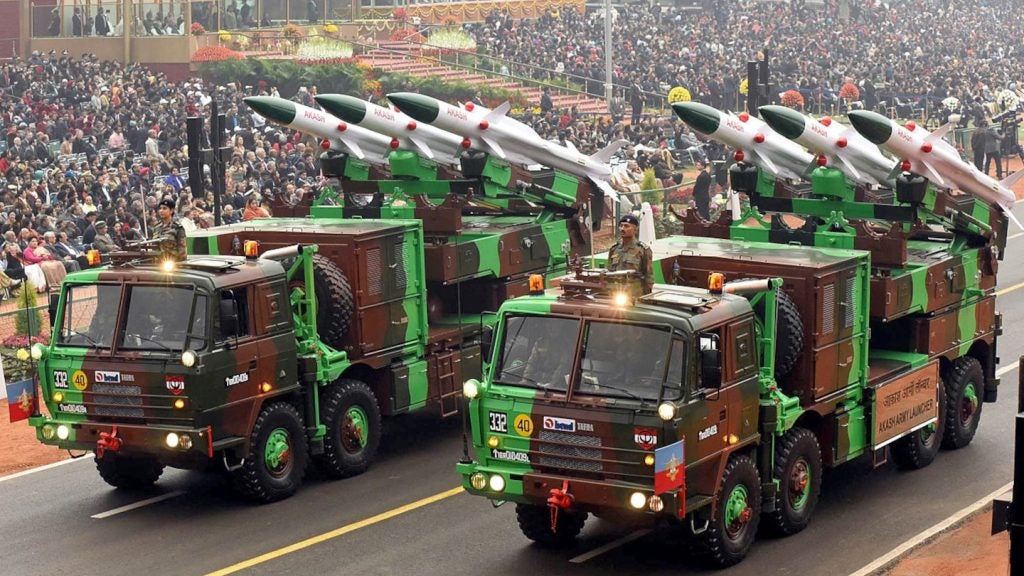The Boeing F-15E dual-role fighter is an advanced long-range interdiction fighter and tactical aircraft. The F-15E is the latest version of the Eagle, a Mach 2.5-class twin-engine fighter. More than 1,500 F-15s are in service worldwide with the US Air Force, US Air National Guard and the air forces of Israel, Japan and Saudi Arabia, including over 220 F-15E fighters.
F-15 Strike Eagle programme and development
The F-15E Strike Eagle made its first flight in 1986. It is armed with air-to-air missiles that can be launched from beyond visual range, and has air-to-ground capability to penetrate hostile air and ground defences to deliver up to 24,000lb of precision ordnance. Since 2001, US Air Force F-15E aircraft have been almost exclusively used for close-air support.
In April 2001, Boeing received a contract for a further ten F-15E Strike Eagle aircraft for the USAF, bringing the total to 227. The air force initially planned to purchase 392 F-15s. The first production model of the F-15E was delivered to the 405th Tactical Training Wing, Luke Air Force Base, Arizona, in April 1988. The ‘Strike Eagle’, as it was dubbed, received initial operational capability on 30 September 1989.
Boeing is upgrading the programmable armament control set and software for the delivery of precision weapons like the joint direct attack munition (JDAM), joint stand-off weapon (JSOW) and the wind-corrected munition dispenser (WCMD).
The aircraft also have improved night vision capability and three new active-matrix liquid crystal displays.
In December 2005, the Government of Singapore placed an order for 12 F-15SG aircraft. Deliveries are scheduled for mid-2009 to 2012. In October 2007, Singapore ordered an additional 12 aircraft. The first F-15SG was rolled out in November 2008. Deliveries of F-15SGs are to begin in second quarter 2009 and continue till 2012.
In August 2008, the F-15E became the first fighter to fly powered by a blend of synthetic fuel and JP-8. The USAF intends to certify its entire fleet of aircraft for flight using the blended fuel by 2011.
F-15SE Silent Eagle stealth variant
In March 2009, Boeing unveiled the F-15 Silent Eagle (F-15SE) at St Louis, Missouri, USA.
“The F-15 Silent Eagle is designed to meet our international customers’ anticipated need for cost-effective stealth technologies, as well as for large and diverse weapons payloads,” said Boeing F-15 programme vice president, Mark Bass.
Using a modular design approach, the F-15SE possesses aerodynamic, avionic, and stealth features. Key elements of the F-15SE include aerodynamic improvements, RCS reductions, an internal weapons bay and advanced avionics enhancements.
Aerodynamic changes to the F-15SE will improve the aircraft’s aerodynamic efficiency and fighter performance by reducing overall airframe weight and drag. The RCS reduction methods are applied to the airframe for frontal aspect stealth capability thus improving mission effectiveness.
The modular internal weapons bay contributes to the overall aircraft RCS reduction package while maintaining strike capability. The enhanced avionics include an integrated active electronically scanned array (AESA) radar and digital electronic warfare system (DEWS) that provides the pilot with greater situational awareness.
The internal carriage conformal fuel tanks (CFTs) can be quickly replaced by the large payload external carriage CFTs which are optimised for increased weapons load. The innovative Silent Eagle is a balanced, affordable design solution based on the combat-proven F-15 Eagle.
The new sophisticated F-15SE internal carriage capability minimises aircraft radar signature and significantly increases pilot tactical options. It is equipped with two internal bays designed for multiple carriage configurations.
The F-15SE is capable of carrying electronic warfare, reconnaissance equipment, side-looking radar, and jamming equipment. The fighter plane’s reconfigurable capability provides enhanced combat flexibility. It is adaptable with each application reconfigurable every 30 minutes.
The elite F-15SE signature reduction methods are applied to the airframe for frontal aspect stealth capability, which ensure greater survivability in the battlefield. The F-15 family has a combat record of 101 victories and zero losses. The US Air Force’s F-15E has flown thousands of combat missions during worldwide combat operations.
F-15K Slam Eagle next-generation South Korean fighter
In April 2002, the Republic of Korea chose the F-15K as its next-generation fighter. 40 aircraft, to be known as the ‘Slam Eagle’, have been ordered. The first flight of the F-15K took place in March 2005 and deliveries began in October 2005. The F-15K entered operational service in July 2008 and deliveries concluded in October 2008. It was confirmed in April 2008 that 21 more would be ordered in 2010, the quantity includes an additional aircraft to replace one which crashed in 2006.
The South Korean Air Force received the last shipment of new F-15K fighter in October 2008 completing its decade-long project to procure 40 of the highly manoeuvrable aircraft. US aircraft manufacturer Boeing delivered F-15ks to the South Korea’s 11th Fighter Wing in Daegu.
The F-15K is powered by General Electric F110-GE-129 engines and features a new electronic warfare suite including BAE Systems IEWS ALR-56C(V)1 radar warner, BAE Systems IDS ALE-47 countermeasures dispenser system and Northrop Grumman ALQ-135M radar jammer.
Lockheed Martin will provide the Tiger Eyes sensor suite with targeting pod (mid-wave staring array FLIR, laser and CCD TV), navigation pod (terrain following radar and mid-wave staring array FLIR) and long-range IRST (infrared search and track). Raytheon will supply the AN/APG-63(V)1 multi-mode radar. BAE Systems will provide the AN/APX-113 IFF (identification friend or foe) system. Data Link Solutions will supply the MIDS fighter datalink.
Kaiser Electronics will provide the cockpit display suite including: five flat panel colour displays (FPCD), four 6in multi-purpose displays (MPD) and wide field of view head-up display (HUD). The FCPD and MFD feature active matrix liquid crystal display (AMLCD) technology.
The Republic of Korea has ordered Raytheon AIM-120 AMRAAM and AIM-9X Sidewinder air-to-air missiles and Boeing SLAM-ER stand-off land attack missiles for the new aircraft. First flight of a SLAM-ER, which has a range of 278km (150nm), onboard an F-15E took place in February 2004. In 2010, the Republic of Korea Air Force also plans to procure AGM-158 joint air-to-surface stand-off missiles (JASSM).
Cockpit
While F-15A/C aircraft are single-crew aircraft, F-15B/D/E have a crew of two. The F-15E Strike Eagle is crewed by the pilot and the weapon systems officer (WSO).
The WSO is equipped with two Sperry full-color and two Kaiser single-color cathode ray tubes. The WSO can access information from the radar, electronic warfare or infrared sensors, and monitor aircraft or weapons status and possible threats. The WSO also selects targets and navigates with the aid of a moving map display, produced by an AlliedSignal remote film strip reader.
The pilot’s crew station features one full-colour and two single-colour cathode ray tubes. These are being upgraded to Rockwell Collins 5in Flat Panel Colour Displays using active matrix liquid crystal display (AMLCD) technology. A holographic wide-field-of-view head-up display (HUD) from Kaiser provides the pilot with flight and tactical information.
USAF F-15s are scheduled to receive the joint helmet-mounted cueing system (JHMCS) developed by Vision Systems International. A contract for 145 systems was placed in July 2008. Deliveries are underway and are scheduled to conclude in mid-2009.
Weapons
The F-15E aircraft can carry payloads up to 23,000lb. The aircraft can carry up to four Lockheed Martin / Raytheon AIM-9LM infrared-guided Sidewinder air-to-air missiles, up to four Raytheon AIM-7F/M radar-guided Sparrow air-to-air missiles, or eight Raytheon AMRAAM radar-guided, medium-range air-to-air missiles.
Ranges for these missiles are: Sidewinder: 8km; Sparrow: 45km; and AMRAAM: 50km.
The range of air-to-ground ordnance includes guided GBU-10, -12, -15 and -24 bombs, and Raytheon AGM-65 Maverick infrared-guided missiles. Maverick’s range is 25km.
The first units of GBU-15 glide bomb upgraded with Global Positioning System (GPS) guidance have been delivered for deployment on the F-15E. The Joint Direct Attack Munition (JDAM) was cleared for carriage on the F-15E in February 2005. The aircraft will also be able to carry the Lockheed Martin AGM-158 joint air-to-aurface atand-off missile.
The F-15E is the first aircraft to be armed with the Boeing GBU-39 GPS-guided 113kg (250lb) small diameter bomb. Up to 12 bombs can be carried. The SDB entered Low-Rate Initial Production (LRIP) in April 2005 and achieved Initial Operating Capability (IOC) on the F-15E in September 2006.
The aircraft is also armed with an internal General Dynamics M-61A1 20mm Gatling gun installed in the right wing root, which can fire 4,000 or 6,000 shots a minute.
Targeting
The integrated avionics systems provide all-weather, around-the-clock navigation and targeting capability. The Raytheon APG-70 synthetic aperture radar displays high-quality images of ground targets. APG-70 is able to create and freeze the high-resolution ground maps during quick sweeps of the target area, lasting only seconds.
USAF F-15Es are being fitted with the upgraded Raytheon APG-63(V)3 Active Electronically Scanned Array (AESA) radar which has a new transmitter, receiver, data processor and signal data converter. The first was delivered to Boeing for flight tests in September 2006.
The F-15E is fitted with the Lockheed Martin LANTIRN navigation and targeting system. The LANTIRN navigation pod contains a Forward-Looking Infrared (FLIR) sensor, which produces video images that are projected onto the pilot’s HUD, and terrain-following radar. The LANTIRN system can be coupled to the flight control system for hands-off terrain, following at altitudes as low as 200ft. The LANTIRN targeting pod contains a tracking FLIR and laser designator.
After obtaining a radar image of the target area, the F-15E aircrew can designate targets by positioning a cursor on the radar display. The target data is transferred to the LANTIRN system for use by the tracking FLIR, which enables aiming of air-to-ground weapons from up to ten miles. Target tracking data is handed automatically to precision-guided weapons such as low-level laser-guided bombs, which can be guided to the target after release.
In August 2001, Lockheed Martin was selected to provide the Sniper XR as the new Advanced Targeting Pod for USAF F-16 and F-15E aircraft. Sniper XR (extended range) incorporates a high-resolution mid-wave FLIR, dual-mode laser, CCD TV, laser spot tracker and laser marker combined with advanced image processing algorithms.
Operational deployment of the Sniper pod on the F-15E began in January 2005, in support of Operation Iraqi Freedom.
Countermeasures
The aircraft is equipped with an integrated internal electronic warfare suite, including: Lockheed Martin AN/ALR-56C radar warning receiver; Northrop Grumman AN/ALQ-135(V) radar jammer; and Raytheon AN/ALQ-128 EW warner. Northrop Grumman is upgrading the ALQ-135 to band 1.5 standard. It is also fitted with a BAE Systems Integrated Defense Solutions (formerly Tracor) AN/ALE-45 automatic chaff dispenser.
Flight control
The F15E is equipped with a triple-redundant BAE SYSTEMS Astronics flight control system. Using manual terrain following, navigation is possible over rough terrain at altitudes down to 200ft, at nearly 600mph, with the pilot following commands from the LANTIRN system. Automatic terrain following is accomplished through the flight control system linked to the LANTIRN navigation pod’s terrain-following radar.
Engines
F-15Es are equipped with Pratt & Whitney F100-PW-229 low-bypass turbofan engines, which provide 29,000lb of thrust per engine. Using the digital electronic engine control system, the pilot can accelerate from idle power to maximum afterburner within four seconds.


